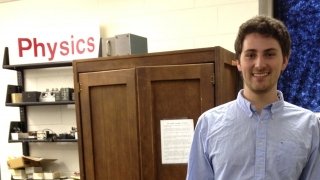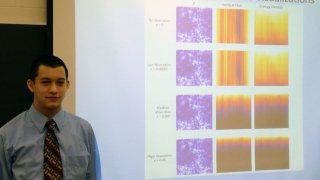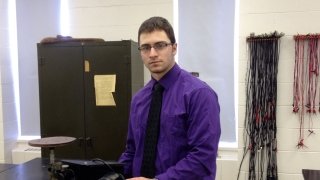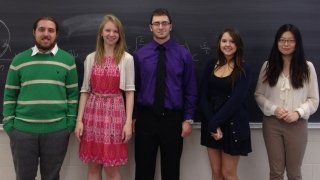Senior Research Projects 2013 - 2014
Seniors present to the physics department the results of their Phys 489/490: SYE Advanced Laboratory and Phys 499: Honors SYE research projects at the end of each semester. The abstracts for their research are below and photos of the student presenters follow afterwards:
Spring 2014
The Pockels Effect in Lithium Niobate - Andrew Freeman '14
Birefringence is an optical property of certain crystals that have different indices of refraction in two crystal directions. When light is incident on these crystals two light beams emerge from the material with orthogonal polarizations. In some crystals birefringence can be induced by the application of an electric field across the appropriate crystal axis; this is called the Pockels Effect. Applications include Pockels Cells, useful in creating voltage-controlled shutters or voltage controlled polarization for lasers. We report our measurements of the electro-optic effect in Lithium Niobate. These measurements include the dependence of the polarization of light on the electric field across the crystal and the rotation of the polarization of light that emerges from the crystal. The latter measurement is used to calculate the induced birefringence of this crystal.
For more information, contact Dr. Catherine Jahncke
Using Video Capture to Enhance Learning in a High School Classroom - Bryan Palermo '14
Constructivism in education can be defined as students constructing their own understanding of knowledge through experiences and reflecting on those experiences. Constructivism is an active process and should revolve around engaging, extending, exploring, evaluating, and explaining. Constructivism in the physics classroom has proven to be a positive approach that enhances student learning and understanding. Physics educators have identified many conceptual problems that students have when they are introduced to kinematics in physics. The most common difficulty that a student has is making the transformation from an Aristotelian point of view to a Newtonian point of view. In my own teaching, I have observed specific problems that students have relating to understanding the concepts of projectile and circular motion. To boost understanding of these common difficulties, I have created hands-on teaching modules that focus on students reaching their own conclusions. I have made videos of objects in motion that demonstrate each of these problematic physics phenomena. Students will then analyze these videos using video-capture software.
For more information, contact Dr. Catherine Jahncke
Fall 2013
The Effect of Non-Zero Absorption on Discrete Angle Radiative Transfer (DART) in Uniform and Multifractal Clouds - Mykael Goodsell-SooTho '14
This study analyzes the effect of adding a non-zero absorption probability into a pre-existing DART model that considered only conservative scattering (i.e. no absorption). We use sparse array techniques to exactly solve the radiance fields of a uniform density cloud as well as two clouds with densities defined by multifractal parameters. In all cases, we model our clouds as being subject to a uniform light source directed downward along the top of the cloud. We find that with non-zero absorption probabilities (defined by the coefficient a), the behavior of radiative transfer quantities fall into two categories depending on the value of a. In the low absorption regime (a = 0.00001 through a = 0.008), the mean downward radiance, vertical flux, and mean energy density versus pixel each mimic the qualitative behavior of the zero absorption case, but at lowered magnitudes. In the high absorption regime (a ≥ 0.01), all radiative transfer quantities fall of exponentially with pixel depth. We also find that in the high absorption regime, the albedo and transmission of each cloud are related to the absorption coefficient by well-defined power laws and exponential laws, respectively. As far as the authors can tell, study is the first of its kind in that the radiance fields of non-conservative DART-based systems are directly solved by sparse matrix inversion techniques.
For more information, contact Dr. Brian Watson




